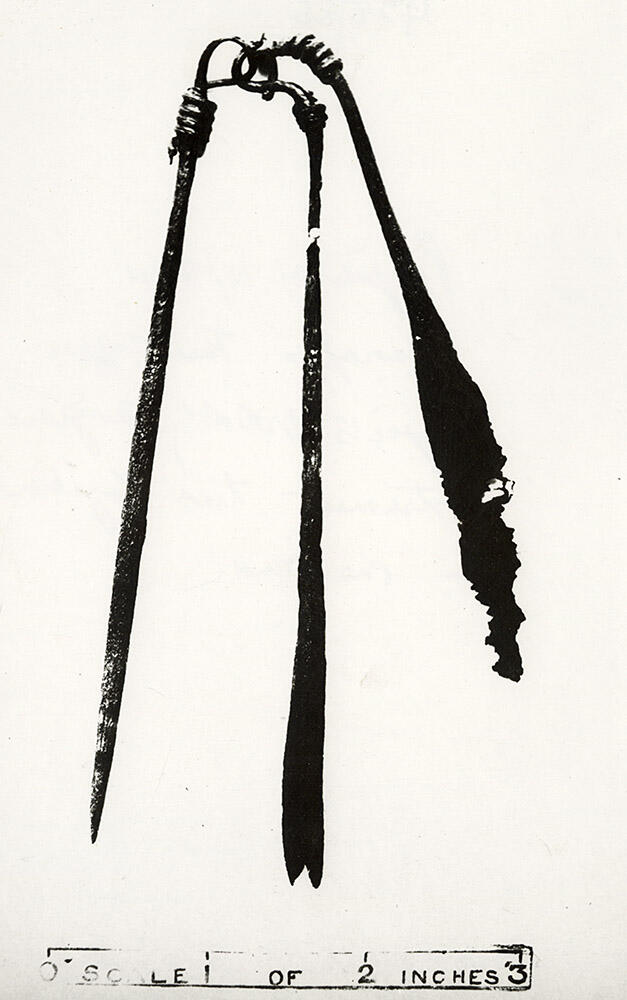"The sites F and A — B and some of the other mounds bid fair to yield many more valuable relics and the deep ravines cut by rain water afford convenient places for reaching the earlier strata with comparatively little trouble. One of these ravines immediately to the south of mound A — B was partly explored during the recent operations and disclosed several interesting relics. One is a beautifully shaped but incomplete vase (Plate XXI, c) the upper part of which is adorned with a branch of a pipal tree. Another object is a handy combination of three copper instruments (Plate XXI, 22) soldered together by their looped ends. They are a sharp-pointed awl, a double-edged knife and a pair of pincers possibly intended for surgical instruments."
- Daya Ram Sahni, 1926. Annual Report Of The Archaeological Survey Of India 1923-24, pg 54. Image: Plate XIX, 22.
Trench E.
"To the south of Excavation B and in the bed of the adjoining deep ravine, the Bai Bahadur cut another shallow trench designated E in which he found the following objects:—
1. Terracotta lingam, Ht. 7/8 in. No. E1269.
2. A bunch1 of three copper instruments connected together by their looped ends. One of the instruments is a double-edged knife, the second a pricker, and the third a pair of pincers. They probably constituted a surgical (?) set. Pl. CXXV, 1. L. 4 3/8, 5, and 5 1/4 in. respectively. No, E3; Depth 3 ft. b.s.
3. Fossilised, bivalve mussel shell. L. 1 1/8 in. No. E25; Depth 3 ft. b.s.
- Madho Sarup Vats, 1940. Excavations at Harappa: Being an account of archaeological excavations at Harappa carried out between the years 1920-21 and 1933-34. Volume I - Text; Volume II - 139 Plates., pg 144. Image Pl. CXXV, 1.
In Vats Chapter XIV, part II Copper, bronze and Silver Utensilsthis object is also listed under "Surgical or Toilet Set".
"No. 1 (E3) in PI. CXXV is a bunch of three bronze instruments* held together by their looped and interlaced ends. Of these, the right hand instrument is a double-edged knife damaged by corrosion, the middle one a pair of pincers and the left hand one a piercing rod.
Length of knife 4.4 in.2 of pincers 5.2 in.; and of piercing rod 5.3 in. Mound AB, Trench in the ravine to south of Naugaza tomb; Depth 3 ft. b. s. "
1. For similar bunches of toilet articles cf. Petrie, Tools and weapons p.52, Plate LXIV figs. 46, 48, and 50-52.↩
2. Its length appears to have been reduced by corrosion.↩
- Madho Sarup Vats, 1940. Excavations at Harappa: Being an account of archaeological excavations at Harappa carried out between the years 1920-21 and 1933-34. Volume I - Text; Volume II - 139 Plates., pg 390. Image Pl. CXXV, 1.
The three copper objects were conjoined by twisting the thin copper to make loops and not by soldering as stated by Vats. They may have been used for cleaning the nails, or the ears or as toothpicks. They were probably not used as surgical tools. Since the objects were not heavily corroded as is common with most Harappan copper objects, it is possible that these are not ancient and were lost by one of the workmen involved in removing bricks from the site.
- Jonathan Mark Kenoyer, 2023.
[Old photo caption] Three Copper Objects

